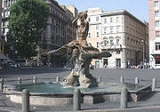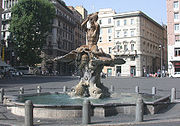
Triton Fountain
Encyclopedia

Baroque
The Baroque is a period and the style that used exaggerated motion and clear, easily interpreted detail to produce drama, tension, exuberance, and grandeur in sculpture, painting, literature, dance, and music...
sculptor Gian Lorenzo Bernini
Gian Lorenzo Bernini
Gian Lorenzo Bernini was an Italian artist who worked principally in Rome. He was the leading sculptor of his age and also a prominent architect...
. Commissioned by his patron, Pope Urban VIII, the fountain is located in the Piazza Barberini, near the entrance to the Palazzo Barberini
Palazzo Barberini
Palazzo Barberini is a palace in Rome, facing the piazza of the same name in Rione Trevi and is home to the Galleria Nazionale d'Arte Antica.-History:...
(which now houses the Galleria Nazionale d'Arte Antica
Galleria Nazionale d'Arte Antica
The Galleria Nazionale d'Arte Antica, or National Gallery of Ancient Art, is an art gallery in Rome, Italy, located on two sites: the Palazzo Barberini and the Palazzo Corsini....
) that Bernini helped to design and construct for the Barberini
Barberini
The Barberini are a family of the Italian nobility that rose to prominence in 17th century Rome. Their influence peaked with the election of Cardinal Maffeo Barberini to the papal throne in 1623, as Pope Urban VIII...
, Urban's family.
The fountain
Fountain
A fountain is a piece of architecture which pours water into a basin or jets it into the air either to supply drinking water or for decorative or dramatic effect....
was executed in travertine
Travertine
Travertine is a form of limestone deposited by mineral springs, especially hot springs. Travertine often has a fibrous or concentric appearance and exists in white, tan, and cream-colored varieties. It is formed by a process of rapid precipitation of calcium carbonate, often at the mouth of a hot...
in 1642–43. At its centre rises a larger than lifesize muscular Triton
Triton (mythology)
Triton is a mythological Greek god, the messenger of the big sea. He is the son of Poseidon, god of the sea, and Amphitrite, goddess of the sea, whose herald he is...
, a minor sea god of ancient Greco-Roman legend, depicted as a merman
Merman
Mermen are mythical male equivalents of mermaids – legendary creatures who have the form of a human from the waist up and are fish-like from the waist down.-Mythology:...
kneeling on the sum of four dolphin tailfins. His head is thrown back and his arms raise a conch
Conch
A conch is a common name which is applied to a number of different species of medium-sized to large sea snails or their shells, generally those which are large and have a high spire and a siphonal canal....
to his lips; from it a jet of water spurts, formerly rising dramatically higher than it does today. The fountain has a base of four dolphin
Dolphin
Dolphins are marine mammals that are closely related to whales and porpoises. There are almost forty species of dolphin in 17 genera. They vary in size from and , up to and . They are found worldwide, mostly in the shallower seas of the continental shelves, and are carnivores, mostly eating...
s that entwine the papal tiara
Papal Tiara
The Papal Tiara, also known incorrectly as the Triple Tiara, or in Latin as the Triregnum, in Italian as the Triregno and as the Trirègne in French, is the three-tiered jewelled papal crown, supposedly of Byzantine and Persian origin, that is a prominent symbol of the papacy...
with crossed keys and the heraldic Barberini
Barberini
The Barberini are a family of the Italian nobility that rose to prominence in 17th century Rome. Their influence peaked with the election of Cardinal Maffeo Barberini to the papal throne in 1623, as Pope Urban VIII...
bees in their scaly tails.
The Tritone, the first of Bernini's free-standing urban fountains, was erected to provide water from the Acqua Felice
Acqua Felice
The Acqua Felice is one of the aqueducts of Rome, completed in 1586 by Pope Sixtus V, whose birth name, which he never fully abandoned, was Felice Peretti. The first new aqueduct of Early Modern Rome, its source is at the springs at Pantano Borghese, off Via Casilina...
aqueduct which Urban had restored, in a dramatic celebration. It was Bernini's last major commission from his great patron who died in 1644. At the Triton Fountain, Urban and Bernini brought the idea of a sculptural fountain, familiar from villa
Villa
A villa was originally an ancient Roman upper-class country house. Since its origins in the Roman villa, the idea and function of a villa have evolved considerably. After the fall of the Roman Republic, villas became small farming compounds, which were increasingly fortified in Late Antiquity,...
gardens, decisively to a public urban setting for the first time; previous public fountains in the city of Rome had been passive basins for the reception of public water.
Bernini has represented the triton to illustrate the triumphant passage from Ovid
Ovid
Publius Ovidius Naso , known as Ovid in the English-speaking world, was a Roman poet who is best known as the author of the three major collections of erotic poetry: Heroides, Amores, and Ars Amatoria...
's Metamorphoses
Metamorphoses (poem)
Metamorphoses is a Latin narrative poem in fifteen books by the Roman poet Ovid describing the history of the world from its creation to the deification of Julius Caesar within a loose mythico-historical framework. Completed in AD 8, it is recognized as a masterpiece of Golden Age Latin literature...
book I, evoking godlike control over the waters and describing the draining away of the Universal Deluge. The passage that Urban set Bernini to illustrate, was well known to all literate Roman contemporaries:
- Already Triton, at his call, appears
- Above the waves; a Tyrian robe he wears;
- And in his hand a crooked trumpet bears.
- The sovereign bids him peaceful sounds inspire,
- And give the waves the signal to retire.
- His writhen shell he takes; whose narrow vent
- Grows by degrees into a large extent,
- Then gives it breath; the blast with doubling sound,
- Runs the wide circuit of the world around:
- The sun first heard it, in his early east,
- And met the rattling ecchos in the west.
- The waters, list'ning to the trumpet's roar,
- Obey the summons, and forsake the shore.
-
- —free translation by Sir Samuel Garth, John Dryden, et al..
-
Two finished terracotta bozzetti at the Detroit Institute of Arts
Detroit Institute of Arts
The Detroit Institute of Arts is a renowned art museum in the city of Detroit. In 2003, the DIA ranked as the second largest municipally owned museum in the United States, with an art collection valued at more than one billion dollars...
, securely attributed to Bernini, reflect his exploration of the fountain's themes of the intertwined upended dolphins and the muscular, scaly-tailed Triton.
Subsequent history
The Triton Fountain is one of those evoked in Ottorino RespighiOttorino Respighi
Ottorino Respighi was an Italian composer, musicologist and conductor. He is best known for his orchestral "Roman trilogy": Fountains of Rome ; Pines of Rome ; and Roman Festivals...
's Fontane di Roma
Fontane di Roma
Fontane di Roma is a 1916 work by the Italian composer Ottorino Respighi, now considered part of the Roman Trilogy of symphonic poems along with Feste Romane and Pini di Roma. Each of the four sections is meant to depict one of Rome’s fountains during different periods of the day and night...
. The legend applied to Trevi Fountain
Trevi Fountain
The Trevi Fountain is a fountain in the Trevi rione in Rome, Italy. Standing 26 metres high and 20 metres wide, it is the largest Baroque fountain in the city and one of the most famous fountains in the world....
has been extended to this: that any visitor who throws a coin into the water (while facing away from the fountain) will have guaranteed their return to Rome.
The setting of the Piazza Barberini has changed significantly since the seventeenth century. Engravings of the time and photographs from the nineteenth century show much lower buildings around the piazza, which would have made the fountain much more dramatic. However, it is a tribute to the artistic judgement of Bernini that even now, with tall buildings around the traffic-ridden piazza, that the Triton Fountain can still maintain a dramatic presence.

